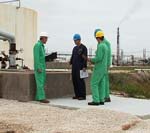"The asbestos-related disease in Libby is far more aggressive and rapidly progressive than what's seen in most asbestos-exposed workers," said Dr. Levin.
EPA is seeking comments on proposed guidance that should make label directions more uniform, specific, and protective of human health.
Over the next four months, manufacturers will test 67 chemicals using a battery of scientific assays and test guidelines from EPA.
The National Institute of Environmental Health Sciences gathered scientists on Oct. 6 to begin an integrated research initiative that will enable a comprehensive assessment of possible health effects.
Scientists in Switzerland say up to 35 percent of the total nanosilver in tested fabrics was released, mostly in the first wash.
As a precaution, EPA alerted West Virginia and Ohio officials of its concerns related to the Philip Sporn facility.

Data could save utilities money and facilitate logistics for repair crews.
Exposure to lead in early childhood significantly contributes to lower performances on end-of-grade (EOG) reading tests among minority and low-income children, according to researchers at Duke University and North Carolina Central University.
Experiment found that subjects who bought green products exhibited less altruistic behavior.
Lawyers refer claims to a consolidated suit in federal court.
EPA Administrator says the agency will be working to strengthen current Toxic Substances Control Act regulations while Congress is considering new legislation.
Using lasers and sensors, a team of researchers has demonstrated a new method of identifying nitric oxide.
EPA is using a multidisciplinary approach in its laboratories to determine how manufactured nanomaterials may harm human health and the environment.
EPA recommends minimizing dust, washing, and vacuuming to lower exposure to caulk that may contain polychlorinated biphenyls in buildings 31 years old or older.
The Governor's Award recognizes PPG's Green Logic paint detackifier.

The second wave of the H1N1 is spreading across the nation. Projections say that the H1N1 virus could cause 30-40% absenteeism among the workforce. This may make it necessary for co-workers or management to assume unfamiliar or less familiar tasks.